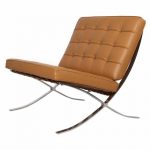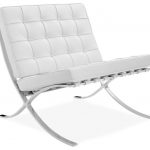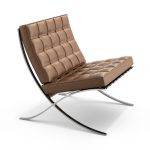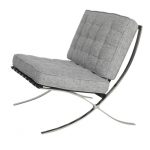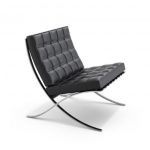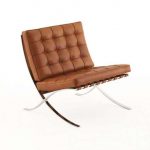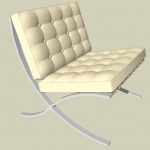The Barcelona Chair is undoubtedly one of the symbols of modernism in the 20th century and will set a new standard in furniture design in the coming decades. Its design embodies both of its creator’s famous credos: “Less is more” and “God is in the details”.
The design has been reduced to the essentials, which makes the shape of the chair very minimalist and pure. The chair consists of three main components: a stainless steel frame and two tufted leather cushions. The frame consists of two x-shaped sections that serve as chair legs and supports for the cushions. Its unique X shape is achieved through the use of curved steel strips that are welded at the interface. The welds are ground and polished, which gives the frame a smoother look and looks like a single, seamless piece of metal. The cushions are made from cowhide. After cutting into square sections, the leather is tufted and framed to form rectangular cushions and placed on leather strips that are riveted to the frame of the chair. The overall look of the chair is extremely appealing and stylish. It’s very proportional and balanced, and the use of the frame makes it look both airy and light. Unlike fully upholstered furniture, it does not obstruct the room in which it is placed, but improves the perception of spaciousness. Even today, almost nine decades after its presentation, when modernity is no longer an extravagant or radical concept, the Barcelona chair has neither aged nor become banal. It still looks fresh and contemporary.
The Barcelona Collection
1929 the German pavilion at the International Exhibition in Barcelona. The futuristic structure of glass, steel and marble, which soon became the benchmark for modern architecture, was the place where the Spanish King Alfonso XIII. The German part of the exhibition opened. The pavilion contained two extraordinary chairs and a pair of matching stools – together they formed the cornerstone of Barcelona’s famous furniture collection.
story
The design of the Barcelona collection, as well as the pavilion itself, were created by Ludwig Mies van der Rohe – the legendary modernist and an icon of 20th century architecture and design who abandoned the idea of ??decorative, bourgeois shapes in favor of elegance and simplicity.
The origins of furniture designs can be traced back to the beginning of the modern movement. Contrary to the historical trend of incorporating the past into furniture design, this era was defined by the idea of ??creating timeless, universal objects that withstand the passage of time. This belief led to simpler, cleaner designs that were less likely to become obsolete. The concept of the simplified design was later developed by the Bauhaus, with which Mies van der Rohe was closely associated. The main principle of the Bauhaus was to make everyday mass products beautiful and yet practical and still make them accessible to ordinary people. The idea of ??making very simple and fully functional, yet elegant and stylish objects, was present in the design of the furniture in the Barcelona Collection from the very beginning. In fact, not only was such furniture on display, but the two chairs were designed to provide comfortable seating for the King and Queen of Spain during the opening ceremony of the exhibition.
 decorafit.com Design ideas for your home and patio
decorafit.com Design ideas for your home and patio

